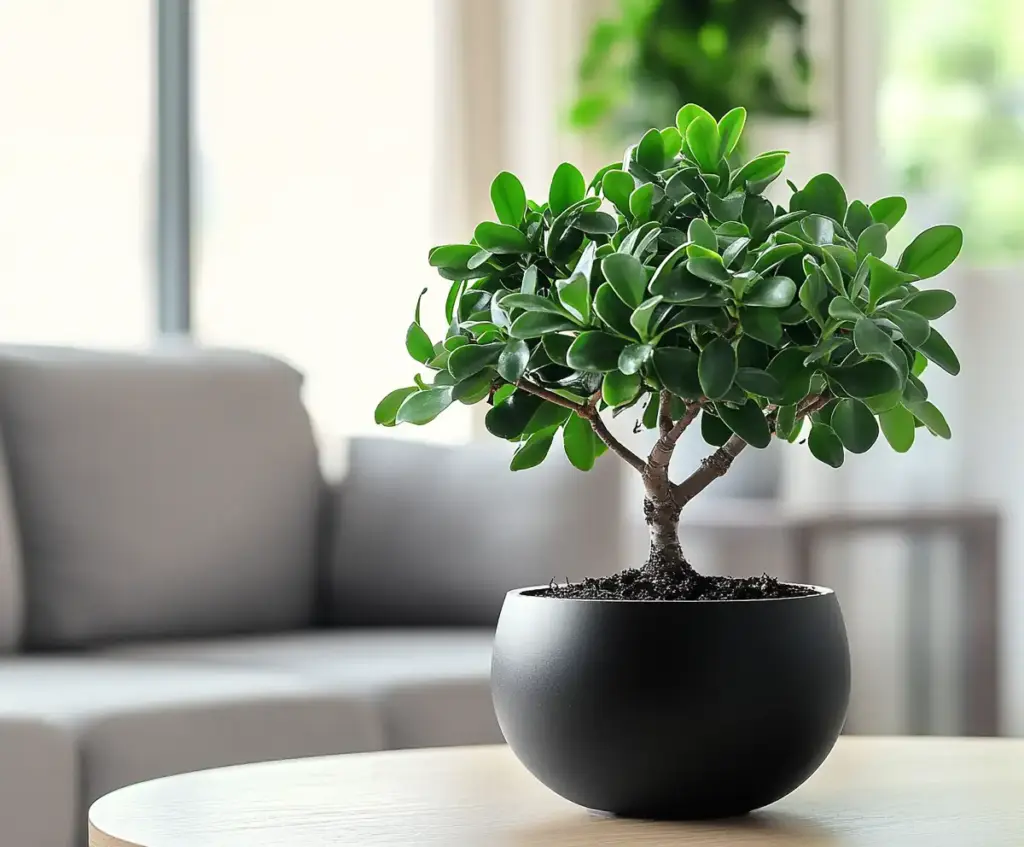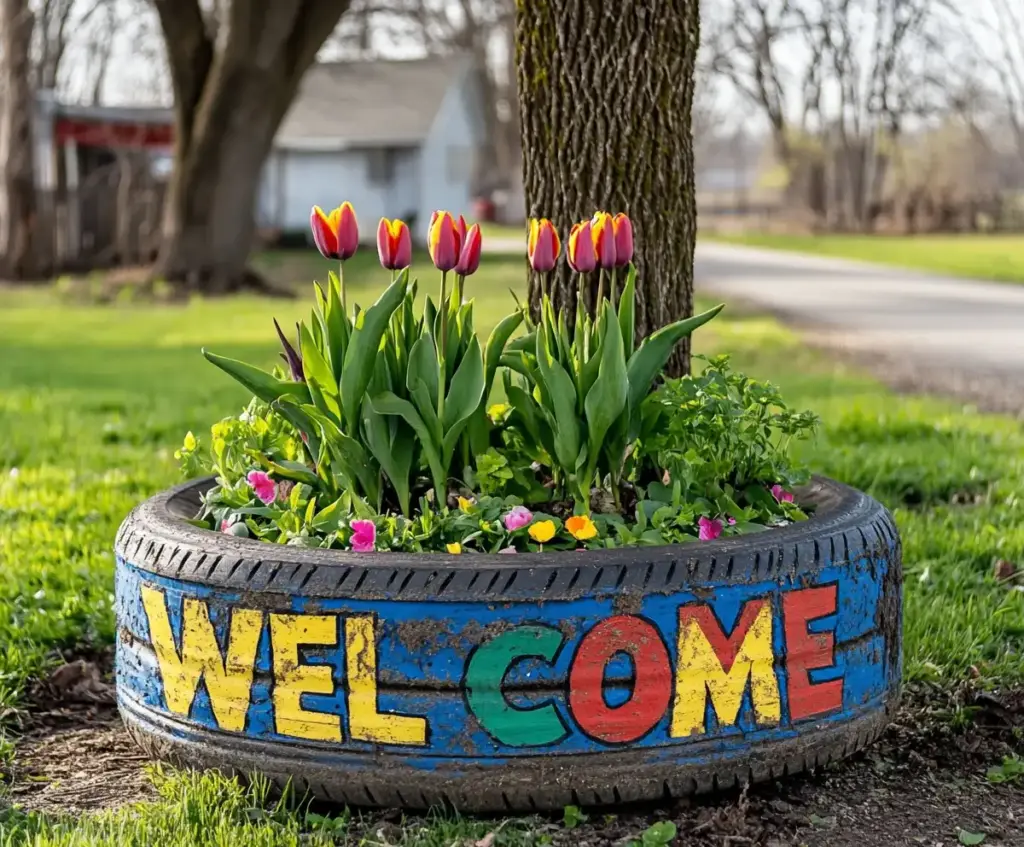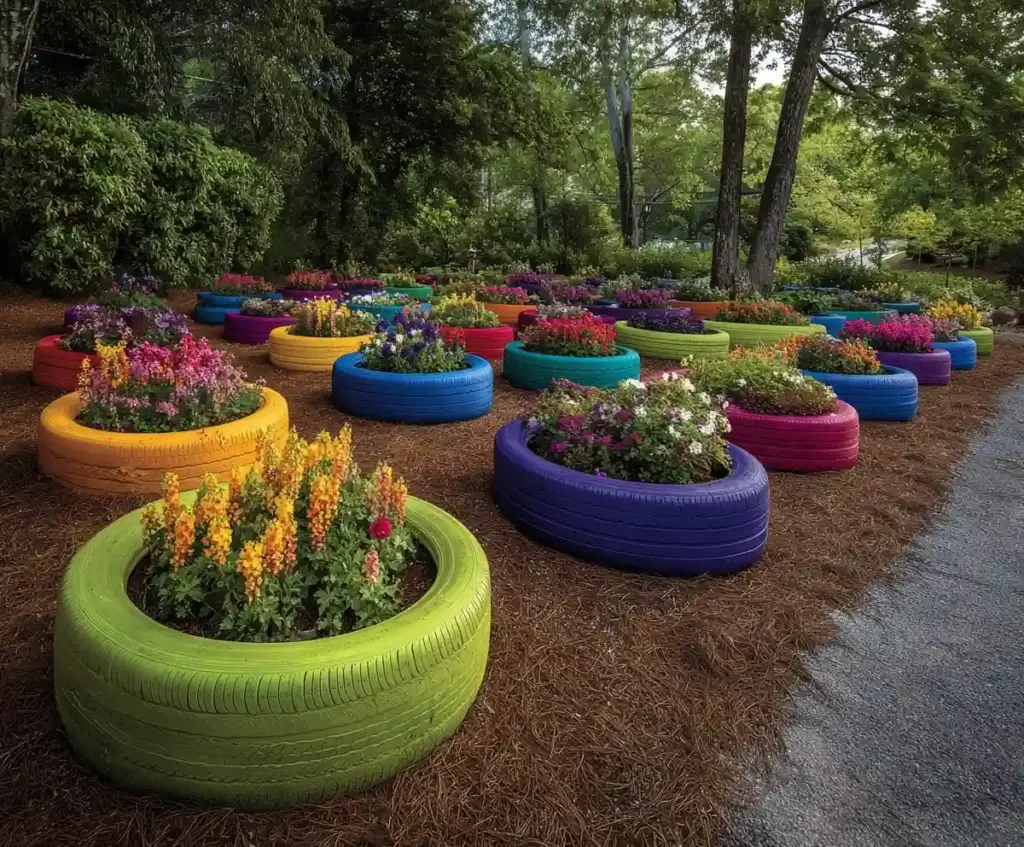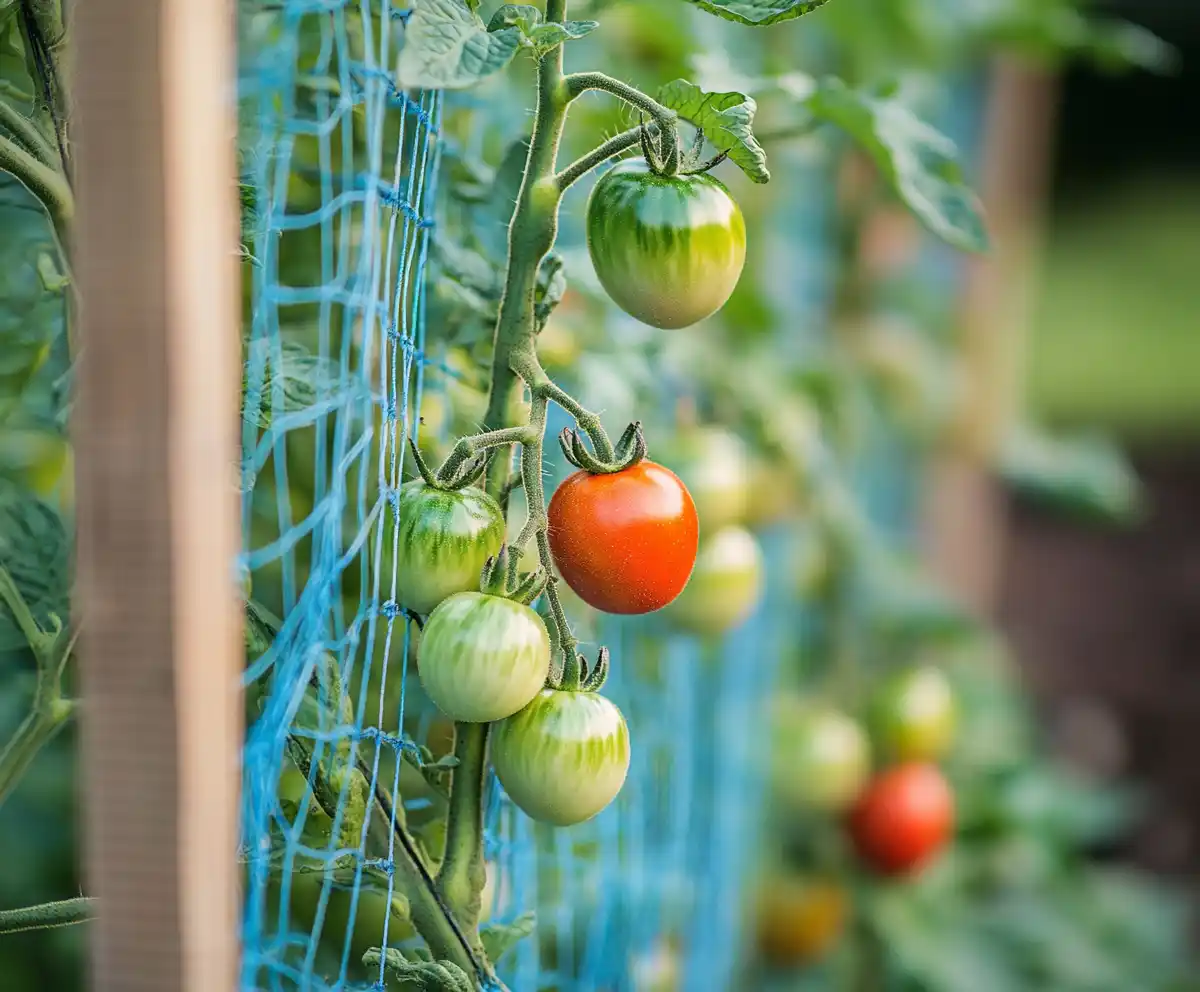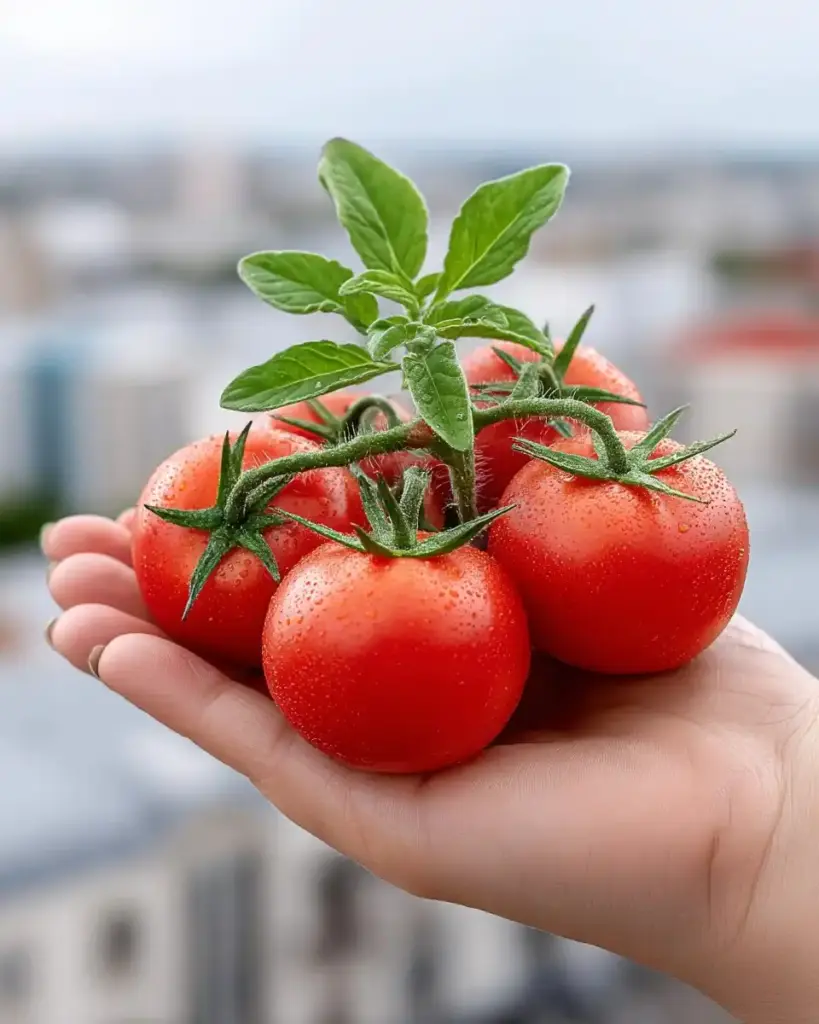Growing tomatoes is one of the most rewarding parts of home gardening—watching those vibrant red fruits ripen under the sun is pure joy. But without the right structural support, tomato plants can quickly become a tangled mess, inviting pests, disease, and disappointment. That’s exactly why incorporating smart tomato trellis ideas is essential. Using a trellis helps keep tomato vines off the ground, improves airflow between leaves, minimizes the risk of fungal infections, and makes harvesting much easier. It also promotes healthier growth and adds a neat, intentional look to your garden beds or container setups.
Whether you’re working in a small backyard vegetable garden or experimenting with raised bed gardening (avoid common mistakes here), selecting the right tomato trellis ideas ensures your plants grow upward and thrive. Trellising is also a game-changer if you’re practicing vertical gardening techniques—which can be seen in action through our DIY trellis guide. In this complete beginner’s guide, we’ll explore five tried-and-true tomato trellis ideas, offering clear setup instructions, pros and cons, and best-use cases so you can confidently match the ideal trellis to your tomato variety and available space.
Table of Contents
Why Use a Trellis for Your Tomatoes?
When it comes to growing healthy, productive tomatoes, support is essential. That’s why smart gardeners turn to tomato trellis ideas—not just for aesthetics, but for real, measurable benefits to the plant’s health and your overall harvest.
1. Prevents Ground Contact
Tomato plants naturally sprawl. Without support, their vines rest directly on the soil, making them more vulnerable to rot, mold, and pests. A trellis lifts the plant upward, keeping foliage and fruit clean and dry.
2. Reduces Disease and Pest Exposure
Good airflow is one of your best defenses against common tomato issues like blight and fungal infections. Trellising promotes better air circulation around the leaves and stems, which helps moisture evaporate more quickly and reduces disease pressure.
3. Encourages More Fruit Production
When a plant spends less energy fighting disease or supporting tangled vines, it can focus more energy on fruit production. A well-supported tomato plant often yields more—and better quality—tomatoes.
4. Simplifies Maintenance and Harvesting
From pruning to picking, everything becomes easier when your tomatoes are upright. No more digging through dense, ground-hugging foliage to find hidden fruit. You’ll save time and enjoy cleaner, easily accessible tomatoes.
5. Keeps Your Garden Neat and Efficient
Let’s face it—tidy gardens are just more enjoyable to work in. Trellised tomatoes stand tall and organized, maximizing space in small gardens or raised beds and keeping your planting areas looking intentional and productive.
1. Single Stake Trellis
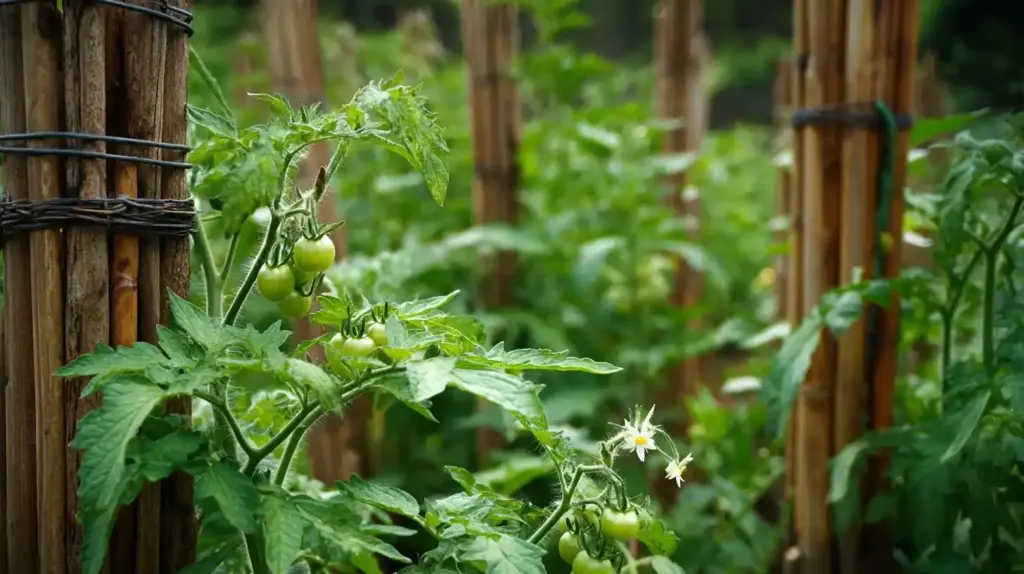
One of the most classic and cost-effective tomato trellis ideas, the single stake method is a go-to option for beginner gardeners. It’s straightforward, affordable, and ideal for smaller tomato varieties that don’t require heavy-duty support.
How to Set It Up
Start by selecting a sturdy wooden or metal stake that stands 5 to 6 feet tall. Push it at least 12 inches into the soil about 2 to 3 inches from the base of your tomato plant. As the plant grows, use soft garden twine or cloth strips to loosely tie the main stem to the stake every 10 to 12 inches.
Tip: Use materials like old t-shirt strips or velcro plant ties—they’re gentle and won’t cut into stems.
Best For:
- Determinate tomatoes (bush varieties), which grow to a set height and produce fruit in a short burst.
Pros
- Budget-friendly and easy to set up
- Ideal for small-space gardens or containers
- No complex materials or construction required
Cons
- Requires frequent maintenance and retying as the plant grows
- Not strong enough to support heavy, vining (indeterminate) varieties
- Can become unstable in windy conditions or loose soil
2. Cage Trellis
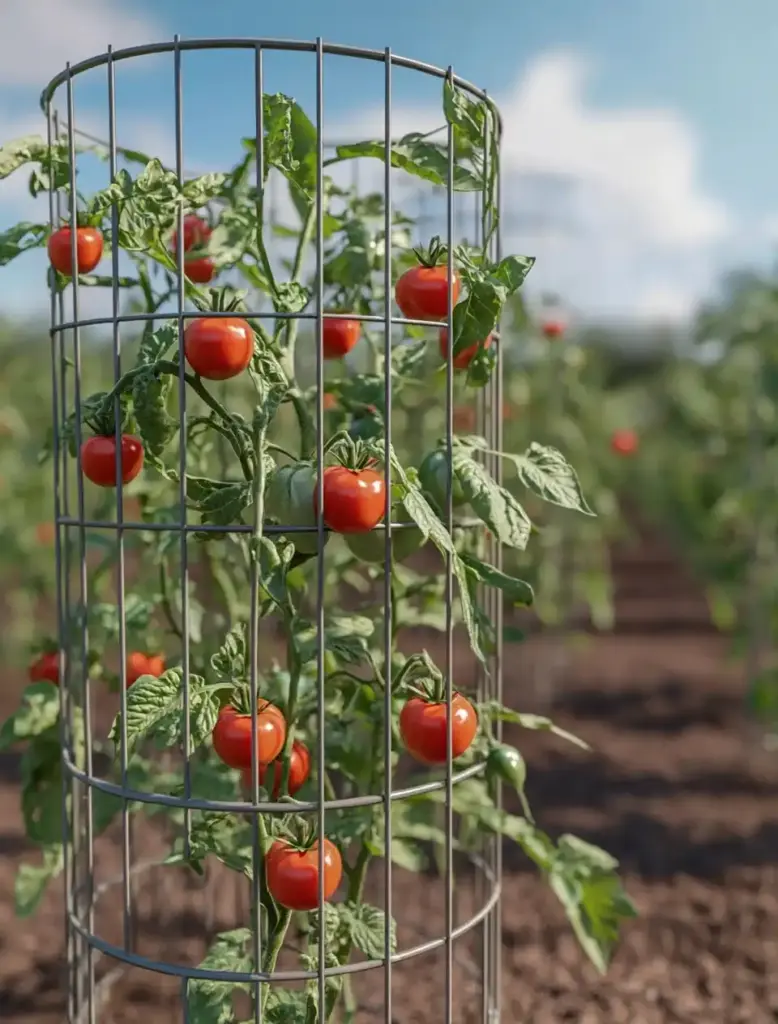
Tomato cages are one of the most user-friendly tomato trellis ideas, especially for those who want a low-maintenance setup. These wire or metal structures offer 360-degree support and allow the plant to grow naturally within the frame.
How to Set It Up
Simply place the cage over your young tomato plant early in the growing season—before it gets too large. As the plant grows, it will naturally weave through the cage for support. You can gently guide stems as needed, but little tying is required.
Tip: Use sturdy cages at least 4 feet tall and wide enough to accommodate mature growth. Avoid the flimsy, cone-shaped types for indeterminate plants.
Best For:
- Determinate varieties
- Small to medium-sized indeterminate tomatoes
Pros
- Very low maintenance—plants support themselves as they grow
- No tying or weaving required
- Great for beginners and small gardens
- Reusable season after season
Cons
- Bulky to store when not in use
- May not support large or top-heavy indeterminate varieties
- Some cheaper models can bend or topple under plant weight
3. Florida Weave Trellis
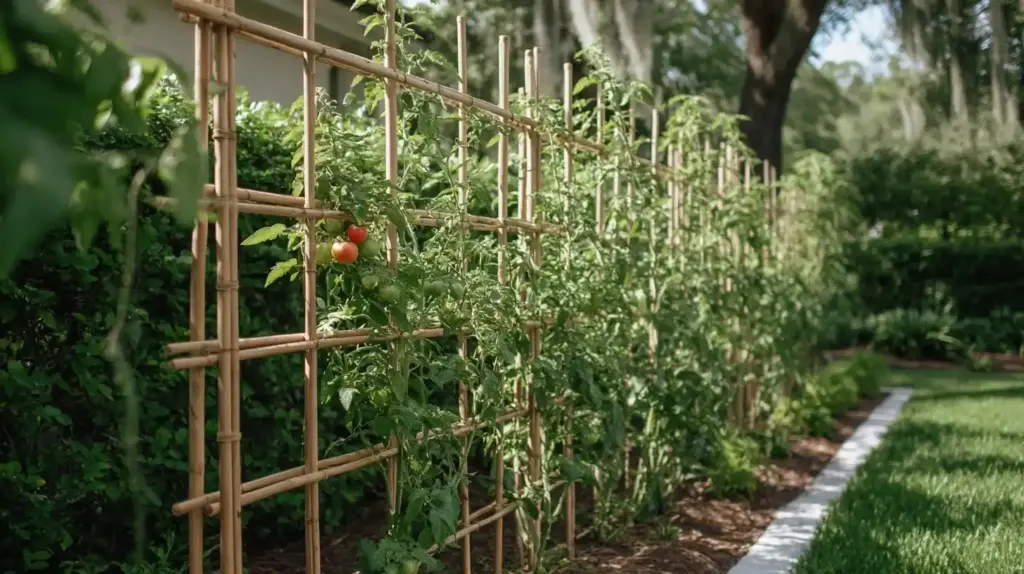
The Florida Weave is a practical and efficient method among tomato trellis ideas, especially if you’re growing multiple tomato plants in a row. Commonly used by commercial growers, this technique uses stakes and twine to sandwich plants between horizontal supports as they grow.
How to Set It Up
Place a stake between every two to three tomato plants—wooden or metal stakes both work well. Starting about 8 inches above the ground, weave garden twine in a figure-eight pattern from one stake to the next, wrapping it around each plant for support. As the plants grow, add additional layers of twine every 8–12 inches up the stakes.
Tip: Use strong twine and keep it taut to prevent sagging. Install the first weave when plants are 12–18 inches tall.
Best For:
- Rows of determinate tomatoes
- Community gardens or large garden beds
Pros
- Supports multiple plants with a single system
- Economical for larger tomato crops
- Provides excellent airflow and access for harvesting
Cons
- Requires regular adjustment and upkeep as plants grow
- Slight learning curve to master the weaving pattern
- Less suited to indeterminate varieties that grow tall and heavy
4. A-Frame Trellis

If you’re looking for sturdy, long-lasting tomato trellis ideas that can handle large, vining tomato varieties, the A-frame trellis is a fantastic DIY solution. It offers plenty of vertical space, great stability, and makes harvesting a breeze.
How to Set It Up
Construct two slanted panels—either from wood or metal—and join them at the top to form an “A” shape. Secure the tops with hinges, rope, or crossbars for added stability. You can add horizontal slats, mesh, or strong twine between the sides for the tomato vines to climb and cling to.
Tip: Space the base wide enough to allow light and airflow, and place the trellis in a position that receives full sun throughout the day.
Best For:
- Indeterminate tomatoes, which continue to grow and produce fruit throughout the season
- Gardeners with ample outdoor space
Pros
- Exceptionally strong and wind-resistant
- Great for tall, heavy tomato varieties
- Reusable year after year
- Offers great vertical gardening potential
Cons
- Requires basic building skills or a pre-made kit
- Takes up more space than other trellis types
- Not ideal for container gardens or small raised beds
5. String Trellis (Vertical String Method)
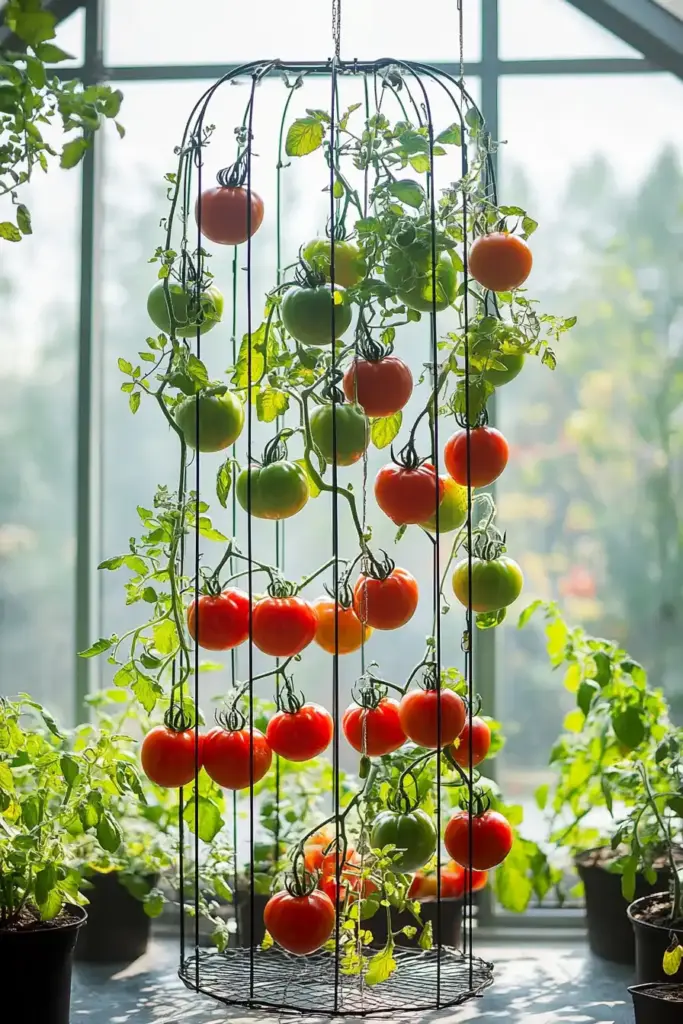
Among the most space-efficient and minimalist tomato trellis ideas, the vertical string method is perfect for indoor gardeners, greenhouse growers, or anyone using an overhead structure. It’s a sleek, functional way to support tall tomato plants without bulky frameworks.
How to Set It Up
Install a horizontal pole, beam, or strong wire above your tomato plants—about 6 to 7 feet high. Tie a piece of garden twine from the overhead support down to the base of each tomato plant. As the plant grows, gently twist or clip the main stem around the string to encourage upright growth.
Tip: Be sure your overhead structure is sturdy enough to hold the weight of mature tomato plants, especially when fruiting.
Best For:
- Indeterminate tomatoes, especially in greenhouses, patios, or sheltered garden beds
- Vertical growing systems or hydroponic setups
Pros
- Ideal for tight spaces and raised beds
- Easy to prune and harvest
- Keeps foliage off the ground and well-aerated
- Creates a clean, professional garden appearance
Cons
- Requires a solid overhead structure or frame
- Not suitable for open, windy areas
- Needs regular training and pruning to keep vines manageable
Tips for Trellis Success
Whether you’re new to growing tomatoes or a seasoned gardener experimenting with new tomato trellis ideas, following a few key best practices will help you get the most from your setup.
1. Use Soft Ties
Always opt for soft materials like garden twine, fabric strips, or plant clips. These prevent damage to the tender tomato stems and allow for natural movement in the wind without cutting into the plant.
2. Check and Adjust Regularly
Tomatoes are vigorous growers—some varieties can stretch several inches in just a few days—so your support system needs to keep up. No matter which tomato trellis ideas you’re using, it’s essential to inspect your plants and trellis setup at least once a week. Look for new growth that needs support, retie stems that are drooping, and tighten any sagging twine or mesh that may no longer be holding the plant upright.
Neglecting these small maintenance steps can result in broken stems, tangled vines, or poor airflow—especially with indeterminate varieties that grow taller and heavier over time. Whether you’ve built your own structure or used a ready-made cage, staying proactive with adjustments is key. For gardeners who prefer hands-on projects, our DIY garden trellis ideas offer clever ways to create support systems that are easy to maintain and customize.
By checking and adjusting your setup regularly, you’ll get the most out of your tomato trellis ideas, helping your plants grow strong, healthy, and incredibly productive.
3. Prune as Needed
Proper pruning is an often overlooked but essential part of maximizing the effectiveness of your tomato trellis ideas. As tomato plants grow, they develop suckers—small shoots that emerge between the main stem and leaf branches. While these might seem harmless, they can divert valuable energy away from fruit production. Regularly removing these suckers, along with lower leaves that touch the soil, helps redirect the plant’s focus toward developing strong stems and juicy, flavorful tomatoes.
Pruning also plays a critical role in maintaining airflow through the plant, which reduces moisture buildup and helps prevent common issues like blight or powdery mildew. This is especially important when you’re growing tomatoes in compact areas or raised beds, where poor circulation can lead to faster disease spread—avoid common raised bed mistakes here.
No matter which tomato trellis ideas you choose—be it a cage, single stake, or vertical string setup—pruning ensures your plants stay tidy, productive, and healthy throughout the growing season.
4. Match the Trellis to the Tomato Type
- Determinate tomatoes need simpler, shorter supports like stakes or cages.
- Indeterminate tomatoes benefit from taller, more robust systems like A-frames or string trellises.
Tip: Know your variety before planting so you can prepare the right trellis ahead of time—trying to retrofit a support mid-season is far more challenging.
Frequently Asked Questions (FAQ)
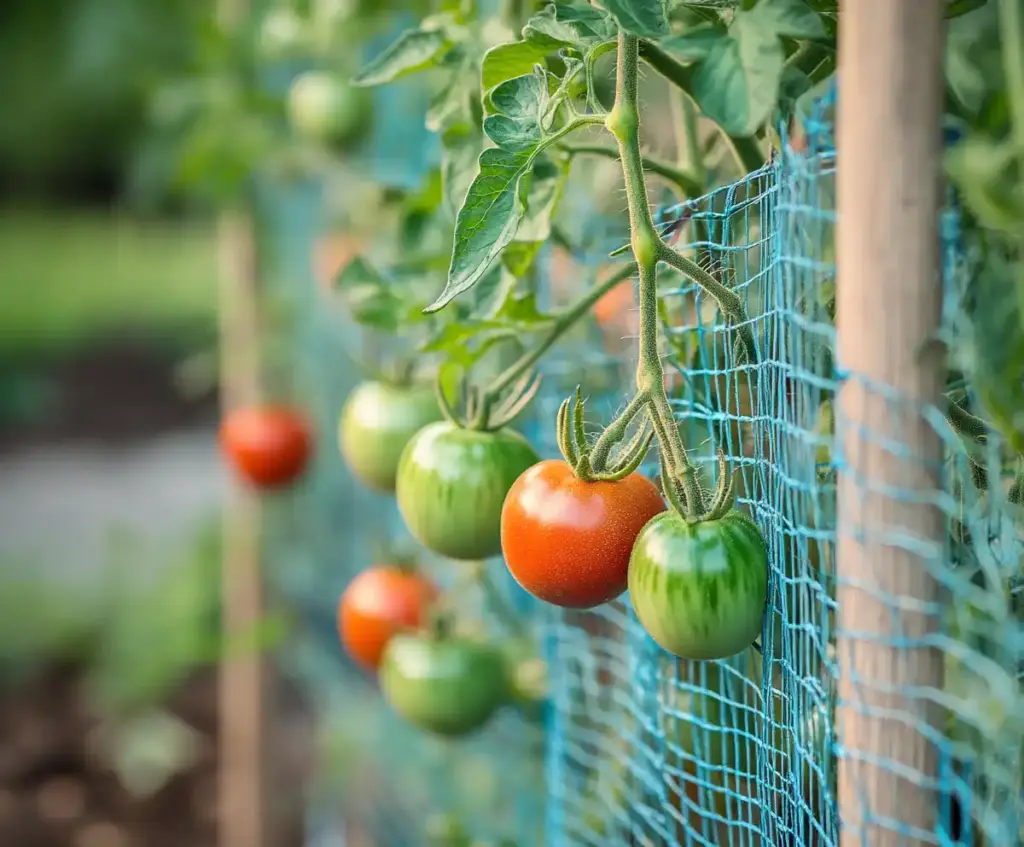
1. What is the best trellis for tomatoes?
The best trellis truly depends on the type of tomato you’re growing and the space available in your garden. For determinate tomatoes—the bushier types that grow to a fixed size—simple supports like single stakes or tomato cages are ideal. These options are easy to set up and work great in smaller gardens or raised beds. If you’re growing in a compact area, consider pairing them with ideas from our small vegetable garden layout tips to make the most of your space.
On the other hand, indeterminate tomatoes, which grow tall and produce fruit over a longer season, benefit from more durable and vertical tomato trellis ideas such as A-frame structures or vertical string trellises. These designs offer robust support throughout the plant’s lifecycle and help reduce disease by improving airflow. For additional inspiration on vertical supports, check out our roundup of garden trellis ideas for vertical gardening, which can be adapted beautifully for tomatoes.
Whether you’re planting in containers, beds, or rows, there’s no one-size-fits-all solution—but with the right tomato trellis ideas, you can tailor your setup for maximum health, yield, and efficiency.
2. When should I set up a tomato trellis?
The ideal time to install your trellis is immediately after transplanting your tomato seedlings into the garden. Setting up your tomato trellis ideas early ensures you won’t disturb the plant’s root system later, which could lead to transplant shock or stunted growth. Early installation also helps guide your plants to grow upward from day one, encouraging stronger stems and reducing the risk of sprawling vines becoming entangled or damaged.
Establishing the trellis at the beginning of the growing season also gives you time to monitor how well each plant adapts to your chosen method—whether it’s a single stake, cage, or a string trellis system. This same principle applies to other climbing vegetables as well. For example, if you’re growing cucumbers, check out these creative cucumber trellis ideas to plan your vertical supports early.
By aligning your garden setup with smart tomato trellis ideas from the start, you’ll make pruning, harvesting, and training your plants much easier throughout the season.
3. How tall should a tomato trellis be?
A well-designed tomato trellis should generally be between 5 to 7 feet tall, especially if you’re growing indeterminate tomato varieties. These vining tomatoes can keep growing throughout the season, often reaching heights that surprise even experienced gardeners. For these varieties, taller and more robust tomato trellis ideas—such as an A-frame or string trellis—offer the support needed to handle both vertical growth and heavy fruit loads.
If you’re working with determinate tomatoes, which grow to a set height, a shorter trellis around 3 to 5 feet tall may be sufficient. However, giving even these bushier plants some extra height can improve airflow and reduce the chance of disease. This concept of vertical support is also crucial when growing other large crops like gourds or pumpkins—our guide on trellising pumpkins offers helpful parallels for managing upward growth in limited space.
Ultimately, selecting height-appropriate tomato trellis ideas not only enhances plant health but also makes pruning and harvesting much easier as the season progresses.
4. Can I use bamboo stakes for trellising tomatoes?
Yes, bamboo stakes are a budget-friendly and eco-friendly option. Just make sure they’re strong enough and tall enough to support your specific tomato variety.
5. Do all tomatoes need a trellis?
Technically, not every tomato plant needs a trellis—but nearly all varieties benefit from one. Even compact, determinate types—often called bush tomatoes—tend to sprawl as they grow and can become tangled or diseased when left unsupported. Using simple tomato trellis ideas, like a single stake or tomato cage, can help keep foliage and fruit off the ground, improving air circulation and sunlight exposure.
For indeterminate tomatoes, a trellis isn’t optional—it’s essential. These vigorous plants can grow 6 to 10 feet tall and will quickly outgrow their space if not trained upward. Supporting them with structures like string trellises or A-frames not only maximizes your vertical growing potential but also improves harvest access and reduces pest problems.
If you’re new to gardening, our guide for beginner vegetable gardening can help you choose tomato-friendly companions and understand which crops thrive best with support. No matter the variety, incorporating smart tomato trellis ideas from the start can lead to healthier plants, bigger yields, and a cleaner, more manageable garden space.
6. What’s the difference between determinate and indeterminate tomatoes?
Understanding the difference between determinate and indeterminate tomatoes is key to choosing the right tomato trellis ideas for your garden.
Determinate tomatoes—also known as bush varieties—grow to a certain height (typically 3 to 5 feet), then stop. They tend to flower and set fruit all at once, making them great for gardeners who want a quick, compact harvest or are working with limited space. These plants do well with simpler tomato trellis ideas like single stakes or sturdy cages.
Indeterminate tomatoes, by contrast, continue growing and producing fruit throughout the season. They can reach 6 to 10 feet (or more) and require consistent support to prevent sprawling, stem breakage, and disease. Taller, more robust tomato trellis ideas—such as vertical string systems or A-frame structures—are ideal for these varieties. For inspiration, check out our full list of vertical gardening trellis ideas that work beautifully for tomatoes and other climbing crops.
By choosing the right trellis based on your tomato type, you’ll ensure your plants grow strong, stay healthy, and produce the best possible yield.
author:Conclusion
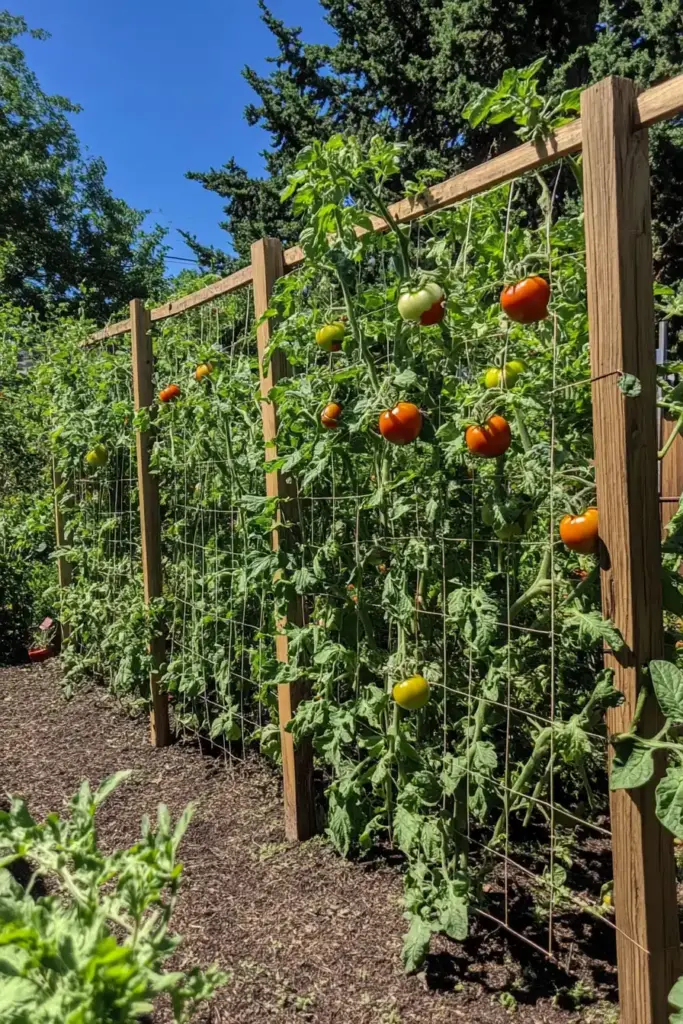
Choosing the right support system can make or break your tomato harvest. Whether you’re starting small with a single stake or going all-in with an A-frame or string trellis, these beginner-friendly tomato trellis ideas offer something for every gardener and every growing space. The key is to match your trellis type to the tomato variety, maintain it regularly, and keep your plants tied and pruned for optimal health. With the right approach, you’ll enjoy cleaner, healthier, and more productive tomato plants all season long.
🌿 Love gardening inspiration? Follow me on Pinterest for bold plant ideas, tips, and seasonal color!
More Posts
